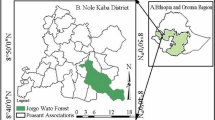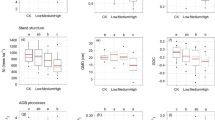Abstract
In order to identify a harvesting model which is beneficial for broadleaf-Korean pine mixed forest (BKF) sustainability, we investigated four types of harvested stands which have been logged with intensities of 0 (T0, control), 15% (T1, low intensity), 35% (T2, moderate intensity), and 100% (T3, clear-cutting), and examined the impacts of logging intensity on composition and structure of these stands. Results showed that there were no significant differences between T0 and T1 for all structural characteristics, except for density of seeding and large trees. The mean diameter at breast height (DBH, 1.3 m above the ground), stem density and basal area of large trees in T2 were significantly lower than in T0, while the density of seedlings and saplings were significantly higher in T2 than in T0. Structural characteristics in T3 were entirely different from T0. Dominant tree species in primary BKF comprised 93%, 85%, 45% and 10% of the total basal area in T0, T1, T2 and T3, respectively. Three community similarity indices, the Jaccard′s similarity coefficient (C J); the Morisita-Horn index (C MH); and the Bray-Curtis index (C N), were the highest for T0 and T1, followed by T0 and T2, and T0 and T3, in generally. These results suggest that effects of harvesting on forest composition and structure are related to logging intensities. Low intensity harvesting is conductive to preserving forest structure and composition, allowing it to recover in a short time period. The regime characterized by low logging intensity and short rotations appears to be a sustainable harvesting method for BKF on the Changbai Mountains.
Similar content being viewed by others
References
Angers V A, Messier C, Beaudet M et al., 2005. Comparing composition and structure in old-growth and harvested (selection and diameter-limit cuts) northern hardwood stands in Quebec. Forest Ecology and Management, 217(2): 275–293. doi: 10.1016/j.foreco.2005.06.008
Chen X W, Li B L, Lin Z S, 2003. The acceleration of succession for the restoration of the mixed-broadleaved Korean pine forests in Northeast China. Forest Ecology and Management, 177(1): 503–514. doi: 10.1016/S0378-1127(02)00455-3
Cheng Xiaoqin, Han Hairong, Kang Fengfeng et al., 2014. Short-term effects of thinning on soil respiration in a pine (Pinus tabulaeformis) platation. Biology and Fertility of Soils, 50(2): 357–367. (in Chinese)
Colwell R K, 2006. EstimateS: statistical estimation of species richness and shared species from samples. Version 8.0. User’s Guide and Application. Available at: http://viceroy.eeb.uconn. edu/estimates.
Dai Limin, Gu Huiyan, Shao Guofan et al., 2004. The Broadleaved-Korean Pine Mixed Forest on Changbai Mountain of China. Shenyang: Liaoning Science and Technology Publishing House, 16–17, 53–54, 70–71, 244–245. (in Chinese)
González-Alday J, Martínez-Ruiz C, Bravo F, 2009. Evaluating different harvest intensities over understory plant diversity and pine seedlings, in a Pinus pinaster Ait. natural stand of Spain. Plant Ecology, 201(1): 211–220. doi: 10.1007/s11258-008-9490-2
Grandpre L D, Archambault L, Morissette J, 2000. Early understory successional changes following clearcutting in the balsam fir-yellow birch forest. Ecoscience, 7(1): 92–100.
Gu H Y, Dai L M, 2008. Structural and compositional responses to timber harvesting for an old-growth forest on Changbai Mountain, China. Journal of Forest Science, 54(6): 281–286.
Hall J S, Harris D J, Medjibe V et al., 2003. The effects of selective logging on forest structure and tree species composition in a Central African forest: implications for management of conservation areas. Forest Ecology and Management, 183(1): 249–264.
Hart J L, Grissino-Mayer H D, 2009. Gap-scale disturbance processes in secondary hardwood stands on the Cumberland Plateau, Tennessee, USA. Forest Ecology, 201(1): 131–146. doi: 10.1007/s11258-008-9488-9
Larsen T H, Williams N M, Kremen C, 2005. Extinction order and altered community structure rapidly disrupt ecosystem functioning. Ecology Letters, 8(5): 538–547. doi: 10.1111/j.1461-0248.2005.00749.x
Magurran A E, 2004. Measuring Biological Diversity. Victoria: Blackwell.
Ma Keping, Liu Canran, Liu Yuming, 1995. Measurement of biotic community diversity. II. Measurement of ß diversity. Chinese Biodiversity, 3(1): 38–43. (in Chinese)
McDonald R I, Motzkin G, Foster D R, 2008. The effect of logging on vegetation composition in western Massachusetts. Forest Ecology and Management, 255(12): 4021–4031. doi: 10.1016/j.foreco.2008.03.054
Nolet P, Doyon F, Messier C, 2014. A new silvicultural approach to the management of uneven-aged Northern hardwoods: frequent low-intensity harvesting. Forestry, 87(1): 39–48. doi: 10.1093/forestry/cpt044
Okuda T, Suzuki M, Adachi N et al., 2003. Effect of selective logging on canopy and stand structure and tree species composition in a lowland dipterocarp forest in peninsular Malaysia. Forest Ecology and Management, 175(1–3): 297–320. doi: 10.1016/S0378-1127(02)00137-8
Parrotta J A, Francis J K, Knowles O H, 2002. Harvesting intensity affects forest structure and composition in an upland Amazonian forest. Forest Ecology and Management, 169(3): 243–255. doi: 10.1016/S0378-1127(01)00758-7
R Development Core Team, 2004. R: A Language and Environment for Statistical Computing. Vienna: R Foundation for Statistical Computing.
Ramovs B V, Roberts M R, 2003. Understory vegetation and environment responses to tillage, forest harvesting, and conifer plantation development. Ecological Applications, 13(6): 1682–1700. doi: 10.1890/02-5237
Shao G F, Wang F, Dai L M et al., 2006. A density-dependent matrix model and its applications in optimizing harvest schemes. Science in China Series E: Technological Sciences, 49(1): 108–117. doi: 10.1007/s11431-006-8112-2
Shao Guofan, Schall P, Weishampel J F, 1994. Dynamic simulations of mixed broadleaved-Pinus koraiensis forests in the Changbaishan Biosphere Reserve of China. Forest Ecology and Management, 70(1–3): 169–181. doi: 10.1016/0378-1127(94)90084-1
Su D K, Yu D P, Zhou L et al., 2010. Differences in the structure, species composition and diversity of primary and harvested forests on Changbai Mountain, Northeast China. Journal of Forest Science, 56(6): 285–293.
Wagner S, Fischer H, Huth F, 2011. Canopy effects on vegetation caused by harvesting and regeneration treatments. European Journal of Forest Research, 130(1): 17–40. doi: 10.1007/s10342-010-0378-z
Wang Hui, Li Qian, Han Xuemei et al., 2011. Effect of harvesting on niche dynamics of main arborous species in broadleavedkorean pine mixed forests in Changbai Mountain. Journal of Northeast Forestry University, 39(10): 18–20. (in Chinese)
Widayati A, Carlisle B, 2012. Impacts of rattan cane harvesting on vegetation structure and tree diversity of conservation forest in Buton, Indonesia. Forest Ecology and Management, 266(1): 206–215. doi: 10.1016/j.foreco.2011.11.018
Xie Xiaokui, Liu Zhenggang, Su Dongkai et al., 2011. Dynamic diameter distribution simulation and optimal management of broad-leaved Korean pine mixed forest in Changbai Mountain. Chinese Journal of Ecology, 30(2): 384–388. (in Chinese)
Yu D P, Zhou L, Zhou W M et al., 2011. Forest management in Northeast China: history, problems, and challenges. Environmental Management, 48(6): 1122–1135. doi: 10.1007/s00267-011-9633-4
Yu Zhenliang, Yu Guirui, Zhao Shidong et al., 2001. Succession and silviculture model of broad-leaved pines Koriensis forests in Changbai Mountain. Resources Science, 23(6): 59–63. (in Chinese)
Zhang Zhaochen, Hao Zhanqing, Ye Ji et al., 2013. Short-term death dynamics of trees in natural secondary poplar-birch forest in Changbai Mountains of Northeast China. Chinese Journal of Applied Ecology, 24(2): 303–310.(in Chinese)
Zhao Fuqiang, He Hongshi, Dai Limin et al., 2014. Effects of human disturbances on Korean pine coverage and age structure at a landscape scale in Northeast China. Ecological Engineering, 71(1): 375–379. doi: 10.1016/j.ecoleng.2014.07.072
Author information
Authors and Affiliations
Corresponding author
Additional information
Foundation item: Under the auspices of National Key Technologies Research and Development Program of China (No. 2012BAD22B04)
Rights and permissions
About this article
Cite this article
Wu, Z., Su, D., Niu, L. et al. Effects of logging intensity on structure and composition of a broadleaf-Korean pine mixed forest on Changbai Mountains, northeast China. Chin. Geogr. Sci. 26, 59–67 (2016). https://doi.org/10.1007/s11769-015-0785-7
Received:
Accepted:
Published:
Issue Date:
DOI: https://doi.org/10.1007/s11769-015-0785-7




